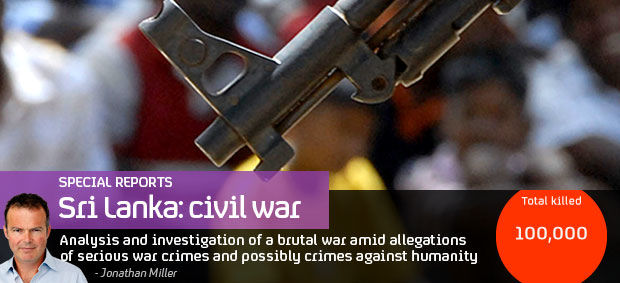Sri Lankan civilians ‘not targeted’, says report
A government-appointed panel finds the Sri Lankan military did not target civilians in the last stages of the civil war, but admits for the first time a “considerable” number were killed in crossfire.
The Lessons Learnt and Reconciliation Commission, appointed by the Sri Lankan government last year, admitted that some isolated allegations of civilian abuses by security forces at the end of Sri Lanka’s civil war in 2009 need to be investigated further.
But it found no evidence of the deliberate killing of civilians in “no fire zones” set up in the final months of the 26-year civil war.
The commission’s report said: “On consideration of all facts and circumstances before it, the commission concludes that the security forces had not deliberately targeted the civilians in the NFZs, although civilian casualties had in fact occurred in the course of crossfire.”
The commission gathered evidence from ethnic minority Tamils, government officials, politicians, civil and religious leaders and former rebels.
But international rights groups refused to testify before it, saying it was pro-government, did not have a mandate to investigate abuses, and did not meet international standards.
The findings clash with a report earlier this year by a UN panel of experts that found the killing of up to 40,000 civilians in the final days of the war, amounting to “credible allegations” that war crimes had been committed.
Read more: The Sri Lankan soldiers told to 'finish the job'
‘Sri Lanka’s Killing Fields’
The commission went on to respond to footage broadcast by Channel 4 over the last two and a half years allegedly showing government troops committing human rights abuses.
The Sri Lankan government has consistently denied war crimes and has criticised Channel 4‘s footage as fake.
Acknowledging that the UN considered the footage real, the report said: “Both rapporteurs contend that despite certain unexplained technical
ambiguities including the contradictions brought up by the government experts, the videos can be considered as authentic.”
Read more: Sri Lanka video is 'astonishing evidence' war crimes lawyer says
But the commission’s own “independent advice from Dr Chathura de Silva and Professor Yfantisand” raised “troubling technical and forensic questions
of a serious nature that cast significant doubts about the authenticity of this video and the credibility and reliability of its content.”
As a result, the LLRC recommended that the government independently investigate the video footage.
Killing Fields
In June Channel 4 broadcast a one-hour film, the Sri Lanka Killing Fields, which showed unedited the graphic videos obtained by Channel 4 News as well as new videos which had emerged. The film, which was cited as “featuring damning new evidence of war crimes and crimes against humanity” caused huge controversy and was broadcast around the world.
It included footage of apparent extra-judicial massacres of prisoners by Sri Lankan government forces, the aftermath of targeted shelling of civilian hospitals and the bodies of female Tamil fighters who appear to have been sexually assaulted.
The film does not only focus on the Sri Lankan government troops – it also examines atrocities carried out by the Tamil Tigers, including the use of human shields, and footage depicting the aftermath of a suicide bombing in a government centre for the displaced.
Sri Lanka’s Killing Fields was shown to the United Nations Human Rights Council at the end of May ahead of the panel of experts report that was released in September.
The panel concluded that “most civilian casualties in the final phases of the war were caused by government shelling”. It alleges Sri Lankan troops shelled civilians in a no-fire zone and targeted hospitals in their push to finish off the Tamil Tigers.
A Channel 4 News investigation by Foreign Affairs Correspondent Jonathan Miller talked to two key witnesses who claimed not only were war crimes committed, but also that they were ordered “from the top.”
One of these eyewitnesses, an army officer, accuses Defence Secretary Gotabaya Rajapaksa – the president’s brother – of ordering Brigadier Shavendra Silva to execute Tamil rebel leaders, whose safe surrender had been guaranteed by the president.
The other new witness, who was also operating with Brigadier Shavendra Silva’s 58 Division on the front line during the final assault, claims the Brigadier was ordered by the defence secretary “to finish the job by whatever means necessary.”
